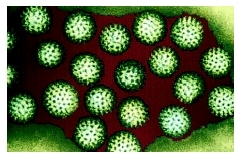Rotavirus infections
Definition
Rotavirus is the major cause of diarrhea and vomiting in young children worldwide. The infection is highly contagious and may lead to severe dehydration (loss of body fluids) and even death.
Description
Gastroenteritis (inflammation of the stomach and the intestine) is the second most common illness in the United States, after the common cold . More than one-third of such cases are caused by viruses. Many different viruses can cause gastroenteritis, but the most common ones are the rotavirus and the Norwalk virus.
The name rotavirus comes from the Latin word "rota" for wheel and is given because the viruses have a distinct wheel-like shape. Rotavirus infection is also known as infantile diarrhea or winter diarrhea, because it mainly targets infants and young children. The outbreaks are usually in the cooler months of winter.
The virus is classified into different groups (Group A through group G), depending on the type of protein marker (antigen) that is present on its surface. The diarrheal infection of children is caused by the group A rotaviruses. Group B rotaviruses have caused major epidemics of adult diarrhea in China. Group C rotavirus has been associated with rare cases of diarrheal outbreaks in Japan and England. Groups D through G have not been detected in humans.
Demographics
In the United States, more than 50,000 children are hospitalized and up to 125 die each year as a result of rotavirus infection. Moreover, worldwide, rotavirus is thought to be responsible for more than 5 to 10 million deaths in children every year. Children in developing countries are particularly hard-hit by this infection, which is thought to be the leading cause of childhood death globally.
Causes and symptoms
The main symptoms of the rotavirus infection are fever , stomach cramps, vomiting, and diarrhea (which can lead to severe dehydration). The symptoms last from four to six days. Symptoms of dry lips and tongue, dry skin, sunken eyes, and fewer than six diapers wet per day indicate dehydration, and a physician needs to be notified. Because of excellent U.S. healthcare, rotavirus is rarely fatal to American children. In developing countries, however, with insufficient means to rehydrate children, rotavirus is oftentimes fatal.
The virus is usually spread by the fecal-oral route. In other words, a child can catch a rotavirus infection if she puts her finger in her mouth after touching toys or things that have been contaminated by the stool of another infected child. This usually happens when children do not wash their hands after using the toilet or before eating food.
The viruses can also spread by way of contaminated food and drinking water. Infected food handlers who prepare salads, sandwiches, and other foods that require no cooking can spread the disease. Generally, symptoms appear within four to 48 hours after exposure to the contaminated food or water.
Children between the ages of six months and two years, especially in a daycare setting, are the most susceptible to this infection. Breastfed babies may be less likely to become infected, because breast milk contains antibodies (proteins produced by the white blood cells of the immune system) that fight the illness. Nearly every child by the age of four has been infected by this virus and has rotavirus antibodies in their body. The disease also targets the elderly and people who have weak immune systems.
Children who have been infected once can be infected again. However, second infections are less severe than the first infections. By the time a child has had two infections, the chance of subsequent severe infection is remote.
Diagnosis
The rotavirus infection is diagnosed by identifying the virus in the patient's stool. This is done using electron microscopy. Immunological tests such as Enzyme-linked immunosorbent assay (ELISA) are also widely used for diagnosis, and several commercial kits are available.
Treatment
Oral rehydration therapy (drinking enough fluids to replace those lost through bowel movements and vomiting) is the primary aim of the treatment. Electrolyte and fluid replacement solutions are available over the counter in food and drug stores. Dehydration is one of the greatest dangers for infants and young children. If the diarrhea becomes severe, it may be necessary to hospitalize the patient so that fluids can be administered intravenously.
Anti-diarrheal medication should not be given to children unless the parent or caregiver is directed to do so by the physician. Antibiotic therapy is not useful in viral illness. Specific drugs for the virus were, as of 2004, not available.
Prognosis
Most of the infections resolve spontaneously. Dehydration due to severe diarrhea is one of the major complications.
Prevention
The best way to prevent the disease is by proper food handling and thorough hand washing, after using the toilet and whenever hands are soiled. In childcare centers and hospital settings, the staff should be educated about personal and environmental hygiene. All dirty diapers should be regarded as infectious and disposed of in a sanitary manner.
Parental concerns
As with any illness that may cause dehydration, the primary parental concern is using an appropriate rehydration

Resources
BOOKS
Bass, Dorsey. "Rotavirus and other agents of viral gastroenteritis." In Nelson Textbook of Pediatrics. Edited by Richard E. Behrman et al. Philadelphia: Saunders, 2004.
Mattson, David O. "Rotaviruses." In Principles and Practice of Pediatric Infectious Diseases , 2nd ed. Edited by Sarah S. Long et al. St. Louis, MO: Elsevier, 2003.
Lata Cherath, PhD Rosalyn Carson-DeWitt, MD
a conserned Parent